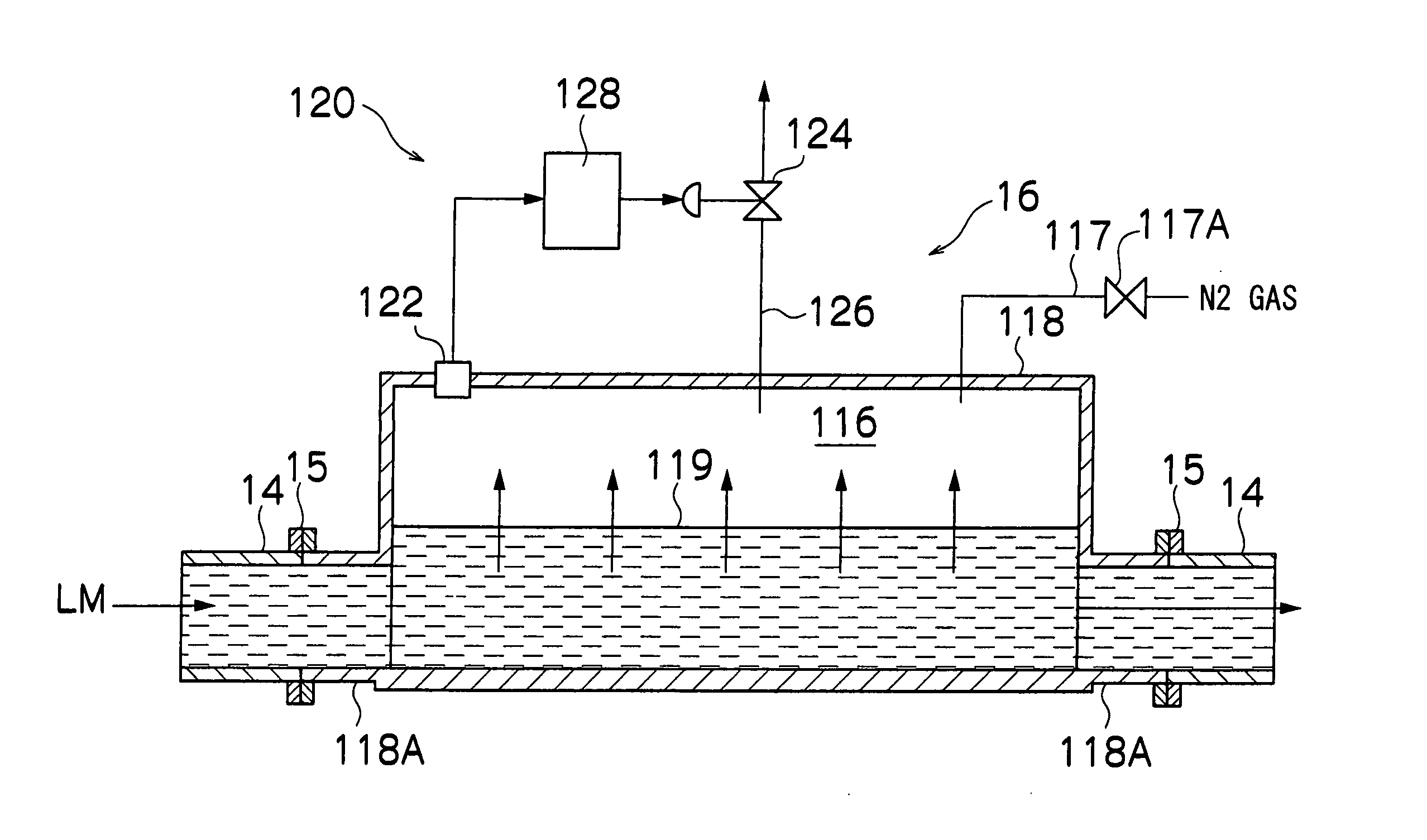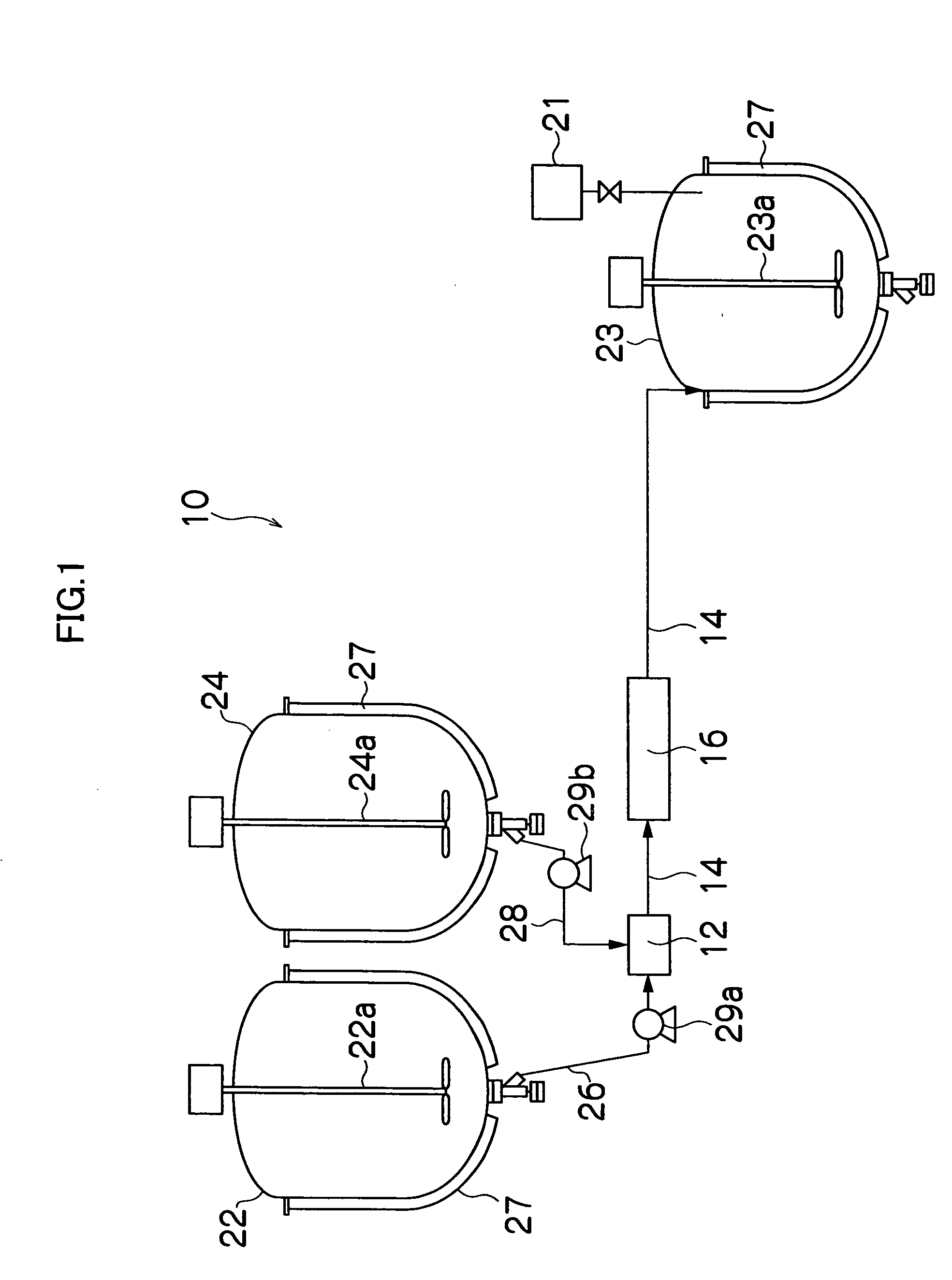Gas-liquid separation method and unit
a gas-liquid separation and gas-liquid technology, applied in the direction of liquid degasification, separation process, dispersed particle separation, etc., can solve the problems of complex apparatus, inability to apply to degassing for a byproduct gas generated by a reaction, and inability to exist, so as to achieve convenient monodispersibility, small particle size, and constant quality
- Summary
- Abstract
- Description
- Claims
- Application Information
AI Technical Summary
Benefits of technology
Problems solved by technology
Method used
Image
Examples
embodiment 1
[0119] In a nitrogen gas of high purity, the operation described below is carried out.
[0120] Into the aqueous solution of a reducing agent having 0.50 g of NaBH4 (made by Wako Pure Chemical Industries, Ltd.) dissolved in 16 ml of H2O (previously deoxygenated into 0.1 mg / l or less of dissolved oxygen), an alkane solution having aerosol 10.8 g of OT (made by Wako Pure Chemical Industries, Ltd.) mixed with 80 ml of decane (made by Wako Pure Chemical Industries, Ltd.) and 2 ml of oleylamine (made by Tokyo Kasei Kogyo Co., Ltd.) was added and mixed to prepare a reversed micelle solution which is a first solution L1.
[0121] Into a metal salt aqueous solution containing 60 g of iron(III) triammonium trioxalate trihydrate (Fe(NH4)3(C2O4)3) (made by Wako Pure Chemical Industries, Ltd.) and 0.50 g of potassium chloroplatinate (K2PtCl4) (made by Wako Pure Chemical Industries, Ltd.) dissolved in 8 ml of H2O (previously deoxygenated into 0.1 mg / l or less of dissolved oxygen), an alkane solution...
embodiment 2
[0128] Except that the amount of H2O (previously deoxygenated into 0.1 mg / l or less of dissolved oxygen) in a first solution L1 of a reversed micelle solution was made to be 40 ml and the amount of H2O (previously deoxygenated into 0.1 mg / l or less of dissolved oxygen) in the second solution L2 of a reversed micelle solution was made to be 20 ml, the same operation was conducted as in the embodiment 1, to obtain a dispersion containing metal nanoparticles of FePt dispersed in a liquid having a mass ratio (water / surface active agent) of water to a surface active agent in the value of 5.
[0129] The metal nanoparticles obtained by a conventional method and a method according to the present invention were subjected to the same measurement as in the embodiment 1, of the yield, the composition, the volume, the average particle diameter and particle size distribution (coefficient of variation), and the coercive force. These measuring methods are the same methods as used in the embodiment 1...
embodiment 3
[0132] Except that the amount of H2O (previously deoxygenated into 0.1 mg / l or less of dissolved oxygen) in the first solution L1 of a reversed micelle solution was made to be 64 ml and the amount of H2O (previously deoxygenated into 0.1 mg / l or less of dissolved oxygen) in the second solution L2 of a reversed micelle solution was made to be 32 ml, the same operation was conducted as in the embodiment 1, to obtain a dispersion containing metal nanoparticles of FePt dispersed in a liquid having a mass ratio (water / surface active agent) of water to a surface active agent in the value of 8.
[0133] The metal nanoparticles obtained by a conventional method and a method according to the present invention were subjected to the same measurement as in the embodiment 1, of the yield, the composition, the volume, the average particle diameter and particle size distribution (coefficient of variation), and the coercive force. These measuring methods are the same methods as used in the embodiment...
PUM
| Property | Measurement | Unit |
|---|---|---|
| Time | aaaaa | aaaaa |
| Pressure | aaaaa | aaaaa |
| Volume | aaaaa | aaaaa |
Abstract
Description
Claims
Application Information
 Login to View More
Login to View More - R&D
- Intellectual Property
- Life Sciences
- Materials
- Tech Scout
- Unparalleled Data Quality
- Higher Quality Content
- 60% Fewer Hallucinations
Browse by: Latest US Patents, China's latest patents, Technical Efficacy Thesaurus, Application Domain, Technology Topic, Popular Technical Reports.
© 2025 PatSnap. All rights reserved.Legal|Privacy policy|Modern Slavery Act Transparency Statement|Sitemap|About US| Contact US: help@patsnap.com



